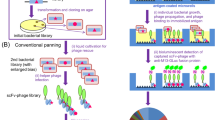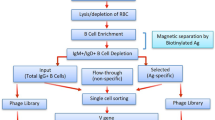Abstract
Here, we describe a protocol for the selection of human antibody fragments using repertoires displayed on filamentous bacteriophage. Antigen-specific clones are enriched by binding to immobilized antigen, followed by elution and repropagation of phage. After multiple rounds of binding selection, specific clones are identified by ELISA. This article provides an overview of phage display and antibody technology, as well as detailed protocols for the immobilization of antigen, the selection of repertoires on purified or complex antigens and the identification of binders.
This is a preview of subscription content, access via your institution
Access options
Subscribe to this journal
Receive 12 print issues and online access
$259.00 per year
only $21.58 per issue
Buy this article
- Purchase on Springer Link
- Instant access to full article PDF
Prices may be subject to local taxes which are calculated during checkout




Similar content being viewed by others
References
Choo, Y. & Klug, A. Toward a code for the interactions of zinc fingers with DNA: selection of randomized fingers displayed on phage. Proc. Natl. Acad. Sci. USA 91, 11163–11167 (1994).
Smith, G.P. Filamentous fusion phage: novel expression vectors that display cloned antigens on the virion surface. Science 228, 1315–1317 (1985).
Hiipakka, M., Poikonen, K. & Saksela, K. SH3 domains with high affinity and engineered ligand specificities targeted to HIV-1 Nef. J. Mol. Biol. 293, 1097–1106 (1999).
Bass, S., Greene, R. & Wells, J.A. Hormone phage: an enrichment method for variant proteins with altered binding properties. Proteins 8, 309–314 (1990).
Demartis, S. et al. A strategy for the isolation of catalytic activities from repertoires of enzymes displayed on phage. J. Mol. Biol. 286, 617–633 (1999).
Heinis, C. et al. Selection of catalytically active biotin ligase and trypsin mutants by phage display. Protein Eng. 14, 1043–1052 (2001).
Christ, D. & Winter, G. Identification of protein domains by shotgun proteolysis. J. Mol. Biol. 358, 364–371 (2006).
Kohler, G. & Milstein, C. Continuous cultures of fused cells secreting antibody of predefined specificity. Nature 256, 495–497 (1975).
Hwang, W.Y. & Foote, J. Immunogenicity of engineered antibodies. Methods 36, 3–10 (2005).
Ascione, A. et al. Application of a synthetic phage antibody library (ETH-2) for the isolation of single chain fragment variable (scFv) human antibodies to the pathogenic isoform of the hamster prion protein (HaPrPsc). Hybridoma 24, 127–132 (2005).
Rahman, Q.K., Berzins, K., Lopez, M.C. & Fernandez, C. Breaking the non-responsiveness of C57BL/6 mice to the malarial antigen EB200—the role of carrier and adjuvant molecules. Scand. J. Immunol. 58, 395–403 (2003).
Srinivas, G.R., Chichester, C.O., Barrach, H.J., Pillai, V. & Matoney, A.L. Production of type II collagen specific monoclonal antibodies. Immunol. Invest. 23, 85–98 (1994).
Birch, J.R. & Racher, A.J. Antibody production. Adv. Drug Deliv. Rev. 58, 671–685 (2006).
McCafferty, J., Griffiths, A.D., Winter, G. & Chiswell, D.J. Phage antibodies: filamentous phage displaying antibody variable domains. Nature 348, 552–554 (1990).
Ilyichev, A.A. et al. Inserting foreign peptides into the major coat protein of bacteriophage M13. FEBS Lett. 301, 322–324 (1992).
Il'ichev, A.A. et al. Production of a viable variant of the M13 phage with a foreign peptide inserted into the basic coat protein. Dokl. Akad. Nauk. SSSR 307, 481–483 (1989).
Whaley, S.R., English, D.S., Hu, E.L., Barbara, P.F. & Belcher, A.M. Selection of peptides with semiconductor binding specificity for directed nanocrystal assembly. Nature 405, 665–668 (2000).
Griffiths, A.D. et al. Human anti-self antibodies with high specificity from phage display libraries. EMBO J. 12, 725–734 (1993).
Lorenz, H.M. Technology evaluation: adalimumab, Abbott laboratories. Curr. Opin. Mol. Ther. 4, 185–190 (2002).
Christ, D., Famm, K. & Winter, G. Repertoires of aggregation-resistant human antibody domains. Protein Eng. Des. Sel. 20, 413–416 (2007).
Barbas, C.F. 3rd, Kang, A.S., Lerner, R.A. & Benkovic, S.J. Assembly of combinatorial antibody libraries on phage surfaces: the gene III site. Proc. Natl. Acad. Sci. USA 88, 7978–7982 (1991).
Hoogenboom, H.R. et al. Multi-subunit proteins on the surface of filamentous phage: methodologies for displaying antibody (Fab) heavy and light chains. Nucleic Acids Res. 19, 4133–4137 (1991).
Lowman, H.B., Bass, S.H., Simpson, N. & Wells, J.A. Selecting high-affinity binding proteins by monovalent phage display. Biochemistry 30, 10832–10838 (1991).
Garrard, L.J., Yang, M., O'Connell, M.P., Kelley, R.F. & Henner, D.J. Fab assembly and enrichment in a monovalent phage display system. Biotechnology (NY) 9, 1373–1377 (1991).
O'Connell, D., Becerril, B., Roy-Burman, A., Daws, M. & Marks, J.D. Phage versus phagemid libraries for generation of human monoclonal antibodies. J. Mol. Biol. 321, 49–56 (2002).
Skerra, A. & Pluckthun, A. Assembly of a functional immunoglobulin Fv fragment in Escherichia coli. Science 240, 1038–1041 (1988).
Bird, R.E. et al. Single-chain antigen-binding proteins. Science 242, 423–426 (1988).
Huston, J.S. et al. Protein engineering of antibody binding sites: recovery of specific activity in an anti-digoxin single-chain Fv analogue produced in Escherichia coli. Proc. Natl. Acad. Sci. USA 85, 5879–5883 (1988).
Choy, E.H. et al. Efficacy of a novel PEGylated humanized anti-TNF fragment (CDP870) in patients with rheumatoid arthritis: a phase II double-blinded, randomized, dose-escalating trial. Rheumatology (Oxford) 41, 1133–1137 (2002).
Ward, E.S., Gussow, D., Griffiths, A.D., Jones, P.T. & Winter, G. Binding activities of a repertoire of single immunoglobulin variable domains secreted from Escherichia coli. Nature 341, 544–546 (1989).
Jones, H.B. On a new substance occurring in the urine of a patient with mollities ossium. Philos. Trans. R. Soc. Lond. 138, 55–62 (1848).
Hamers-Casterman, C. et al. Naturally occurring antibodies devoid of light chains. Nature 363, 446–448 (1993).
Roux, K.H. et al. Structural analysis of the nurse shark (new) antigen receptor (NAR): molecular convergence of NAR and unusual mammalian immunoglobulins. Proc. Natl. Acad. Sci. USA 95, 11804–11809 (1998).
Nuttall, S.D. et al. Isolation of the new antigen receptor from wobbegong sharks, and use as a scaffold for the display of protein loop libraries. Mol. Immunol. 38, 313–326 (2001).
Holt, L.J., Herring, C., Jespers, L.S., Woolven, B.P. & Tomlinson, I.M. Domain antibodies: proteins for therapy. Trends Biotechnol. 21, 484–490 (2003).
Christ, D., Famm, K. & Winter, G. Tapping diversity lost in transformations—in vitro amplification of ligation reactions. Nucleic Acids Res. 34, e108 (2006).
Kristensen, P. & Winter, G. Proteolytic selection for protein folding using filamentous bacteriophages. Fold. Des. 3, 321–328 (1998).
Acknowledgements
Protocols are based on methods originally developed by D. Christ and others in Greg Winter's group at the MRC Laboratory of Molecular Biology and were modified in our laboratory at the Garvan Institute. D.C. was a Fellow of Trinity College (Cambridge University) from 2002 to 2006. This work was funded by a Cancer Institute NSW grant (07/RFG/1-12) to D.C. and a Cancer Institute NSW Early Career Fellowship to F.S. We thank G. Winter for helpful discussions.
Author information
Authors and Affiliations
Corresponding author
Rights and permissions
About this article
Cite this article
Lee, C., Iorno, N., Sierro, F. et al. Selection of human antibody fragments by phage display. Nat Protoc 2, 3001–3008 (2007). https://doi.org/10.1038/nprot.2007.448
Published:
Issue Date:
DOI: https://doi.org/10.1038/nprot.2007.448
This article is cited by
-
Predicting unseen antibodies’ neutralizability via adaptive graph neural networks
Nature Machine Intelligence (2022)
-
A Novel Specific Single-Chain Variable Fragment Diagnostic System for Viral Hemorrhagic Septicemia Virus
Marine Biotechnology (2022)
-
Therapeutic high affinity T cell receptor targeting a KRASG12D cancer neoantigen
Nature Communications (2022)
-
Development of novel detection system for sweet potato leaf curl virus using recombinant scFv
Scientific Reports (2020)
-
Targeting c-Met on gastric cancer cells through a fully human fab antibody isolated from a large naive phage antibody library
DARU Journal of Pharmaceutical Sciences (2020)
Comments
By submitting a comment you agree to abide by our Terms and Community Guidelines. If you find something abusive or that does not comply with our terms or guidelines please flag it as inappropriate.



